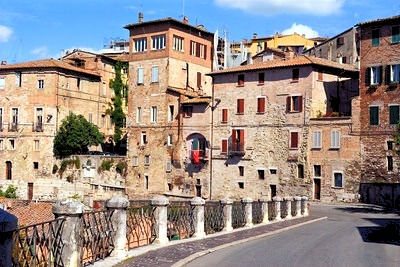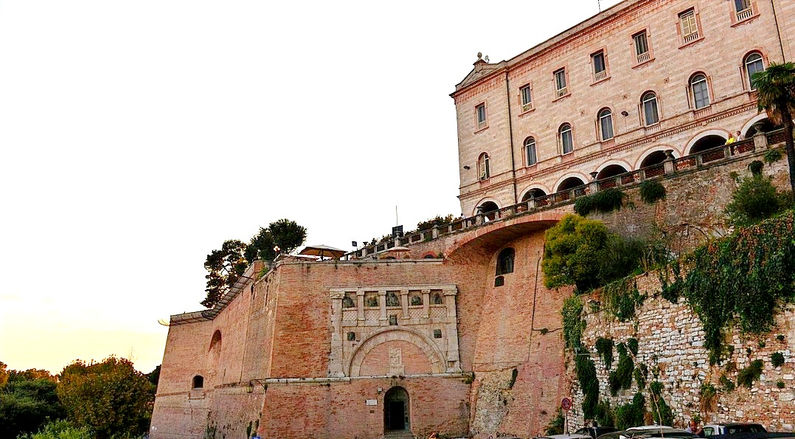
Umbria


Looking for something a little different for your next trip to Italy? Umbria is Italy’s best-kept secrets, a charismatic Italian region , still off the mainstream touristic track. Nestled among the luscious land, often referred to as the green heart of Italy, Umbria is known for its fertile landscape, rolling hills and rich history. Umbria displays fascinating medieval hill towns and villages, tons of culture, Roman ruins, gorgeous lakes, beautiful sceneries, lip-smacking local cuisine and cultural events. You will enjoy an atmosphere of bygone times, among the medieval paths, the palaces, the castles and the fortresses of charming villages. It’s the epitome of holiday heaven, off the beaten path.
Umbria Jazz is one of the main Italian music events, and takes place in Perugia in the middle of July. It is an incredible event for over forty years long, made of a lot of passion, great musicians, and amazing concerts - even outside Perugia.
The UNESCO World Heritage Sites in Umbria are
-
Assisi, the Basilica of San Francesco and Other Franciscan Sites
-
Longobards in Italy and their Places of Power Serial Sites comprises seven groups of historic buildings including fortresses, churches, and monasteries throughout the Italian Peninsula. The seven components are located in Campania, Friuli-Venezia Giulia, Lombardy, Puglia, and Umbria. There are 2 Sites in Umbria.
-
Basilica San Salvatore, Spoleto (Longobard Site)
-
Temple of Clitumnus (Tempietto del Clitunno), Campello sul Clitunno (Longobard Site)
Assisi
A UNESCO heritage site , known for the magnificent medieval architecture and for being the birth and resting place of Saint Francis, founder of the Franciscan Order in 1208. An important pilgrimage site in Italy, but you don’t have to be a Catholic to enjoy the beauty of this postcard-perfect town.
The Basilico, constructed during the 13th century, was built over the tomb of St. Francis of Assis. It is well known for its glorious frescoes by Sienese and Florentine masters, like Giotto and Cimabue. A must visit for any tourist with a passion for religion or art.
Gubbio
Gubbio was built on calcareous stones, that’s why it is called “grey city”. Despite being so close to Assisi, it’s surprisingly set off the main tourist track. Surrounded by avocado countryside and connected to Mount Ingino via a scenic cableway, this hillside Italian town is undeniably magical. When it comes to authenticity, architecture, and atmosphere, Gubbio has it all.
You can visit to the Gothic Consoli Palace, now one of the town’s most prominent icons, home to the “big bell” and the seven Eugubine Tables, dating back to the 3rd-century BC. Other must-do activities include a visit to Gubbio Cathedral with its paintings and baroque chapel, the Dukes Palace, the 1st-century AD Roman ruins just outside the city walls.
Orvieto
Pearched majestically high above the volcanic tufo, a traditional medieval city with amazing medieval Gothic cathedral and square, surrounded by narrow cobblestone streets, historic palace and: a maze of underground tunnels and caves. The town’s crowning glory is the magnificent Orvieto Cathedral, the 14th-century Gothic jewel known for its vibrant glittering, mosaic-adorned façade. and impressive frescoes.
Besides Cathedral, Orvieto’s another main draw is a deep well, named St Patrick’s Well, which extends to a depth of over 50 metres and a large network of underground caves underneath the town. This astonishing St Patrick’s well will leave you appalled. Below Orvieto lies a magical myriad of Etruscan-era tunnels and grottos variously used as wine storage, World War II bomb shelters and a means of escaping sieges during their 3000 year history.
Cathedral
Perugia
Nestled within central Umbria, Perugia is the region’s thriving capital. It’s a fairly big city, with modern outskirts, but its medieval historical center, built up on a cliff, is fairly intact and keeps all its medieval charm. This town has artistic and monumental treasures of a rich past. This picturesque Etruscan town is charmingly medieval, with a backdrop dominated by Italy’s largest fortress, the Rocca Paolina. It looks like a small fortified medieval village, but Perugia has a very busy city life. There is one of oldest University of the Studies of Italy (founded in 1308), as well as the biggest University for foreigners in Italy. Perugia is also the ‘Chocolate Capital of Italy.’ It’s home to world-famous chocolatier, Perugina, creators of the legendary Baci chocolate kisses. Umbria Jazz, one of the main Italian music events, takes place here every year in the middle of July. Perugia is a little jewel that visitors discover slowly.
Temple of Clitumnus (Tempietto del Clitunno)
The former Roman temple dedicated to the river god Clitumnus and transformed into an early-Christian church (probably in the fourth century); located in Campello sul Clitunno, near Perugia.
In 2011, it became a UNESCO World Heritage Site as part of the serial site “Longobards in Italy and their Places of Power Serial Sites” (568-774 A.C.), as part of seven sites recalling the Longobard monuments existing on Italian territory.

Temple of Clitumnus
By Georges Jansoone (JoJan) - wikimedia

Temple of Clitumnus
By De Acul reip - Trabajo propio, - wikimedia
Spello
Nestled in the foothills of Mount Subasio is the picturesque walled town of Spello where honey-colored houses cascading down the slopes, winding medieval streets and century old buildings charm. Don’t miss the Infiorata di Spello (Flower Festival) held in May and June. The streets are transformed into a colorful wonderland, with vibrant floral displays planted by locals, dubbing Spello the ‘Capital of Flowers.’
Spoleto
Spoleto is one of those rare non-touristy towns,totally off the beaten path. this medieval village has a steep historical center, accessible via a modern travellator that can take you up the hill.
The symbol of the city is the huge castle on top of the hill, "The Rocca Albornoziana", a 14th-century former papal fortress, where you can admire the views across Spoleto. You will not miss the Ponte delle Torri (Bridge of Towers), a high stone bridge spanning across a gorge, erected in the 14th century on the foundations of a Roman aqueduct,which connects the San’Elia hill with Monte Luco. Other sites include the the 12th-century Romanesque Santa Maria Assunta Cathedral and 1st-century AD Roman theatre – perhaps you’ll be lucky enough to catch a ballet performance!
Spoleto also known for its summer music, opera and art festival, the "Festival of the Two Worlds" ("Festival dei Due Mondi") which takes place every year between June and July and is one of Umbria's oldest and most important festivals.
Basilica of San Salvatore
The Basilica of San Salvatore is a romanesque-style, basilica located in the center of Spoleto. Built between the 7C and 8C by monks from the east and altered in the 9C, this basilica was one of the first Christian churches in Italy. Its architecture reflects a successful merging of Classic and Eastern styles, an original combination which has led to the building being declared a UNESCO World Heritage Site in 2011, as part of seven sites recalling the Lombards in Italy, “Longobards in Italy and their Places of Power Serial Sites” (568-774 A.C.). The interior is striking for its simple elegance and its many Roman features, such as the columns, which have been re-used in the church's construction.
Terni
Terni is placed in a big valley, where the river Serra and the river Nera meet. It’s a city opened to the future but it doesn’t forget its glorious past. Terni has an ancient history and it stands to reason that it has several ancient structures that have been preserved from its Roman era. You can find ancient monuments such as Roman ancient ampitheatre, built in 32BC, and the Romanesque San Salvatore Cathedral, an early Christian Basilica of circular shape, in the Old Town near Palazzo Spada.
Marmore Waterfall
Nearby Terni, you can’t miss the Marmore Waterfall, one of the most spectacular sights of this area. The Marmore Waterfall , which is an artificial waterfall created by the Romans back in 271 BC . Tucked within Nera River Park, it was made to drain the overflowing stagnant waters of the River Velino into the River Nero. Marmore Falls is one of the tallest human made waterfalls in the world. Today, the falls feed the Galleto Hydroelectric Power Station, which has enabled the metal-working, electrochemical, and electric industries at Terni.
Todi
The hilltop town of Todi overlooks the picturesque Tevere Valley. Surrounded by three sets of walls, the town conceals many hidden treasures. Each wall was built in a different historical era: the innermost is Etruscan, the middle one Roman, and the medieval wall from the Middle Ages.
Lake Trasimeno
Lake Trasimeno, with its hillside olive groves, undulating vineyards, and quaint stone villages, is one of the most enchanting destinations in Umbria. The fourth-largest of Italy’s lakes, Trasimeno is surrounded by ancient towers, fortresses, and Renaissance-style churches. On the lake itself, you’ll find pastel-colored wooden fishing boats, three scenic lake islands, and some of the most dramatic sunsets in Italy. Explore the lake’s islands, towns, and enjoying the decadent cuisine: wine, olive oil, fish, and legumes flourish in Trasimeno’s microclimate.
Ferries run throughout the year to all 3 islands. The biggest island is Isola Polvese, Isola Minore and Isola Maggiore, the only inhabited island.
Castiglione del Lago
Castiglione del Lago, the most popular town, perched on a small promontory, Passignano sul Trasimeno, with its long stretch of beach, is perfect for sunbathing, while San Feliciano is the best spot to witness the fishermen with their traditional flat-bottomed boats.
Truffle Hunting
Umbria might be the green heart of Italy but it’s real culinary treasure likes in the “black diamonds” or truffles found in the region. What better way to learn about the history and art of truffle hunting than to go on a hunt yourself?
Head out into the countryside accompanied by an expert truffle hunter and his trusted dogs in search of the treasured delicacy.

By Andrea Cairone - Unsplash

By pixelia -Pixabay

























































